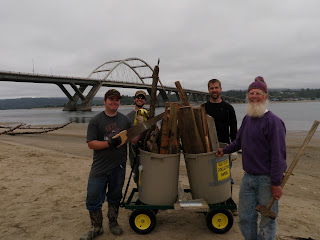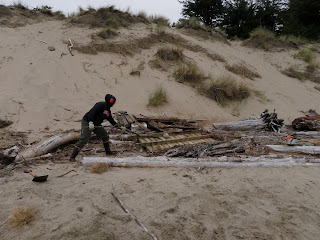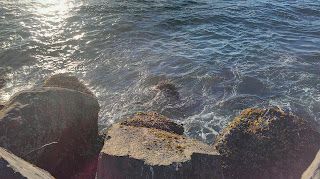Here I sit on the the eve of Week Four, and it's hard for me to believe that it's been 3 full weeks past already in the summer. The last time I wrote to you, I had just finished my first week since starting with ODFW.
As I'm sure you all expect by now, most of what I've done since has been a lot of the same - more running the fish trap on the Siletz River, which has been crazy, by the way. In the last week alone I think we handled somewhere around 500 fish total. Which is a LOT of fish. At this point in the run, we are receiving more fish then we know what to really do with. We recycle them as much as possible, but given how much the water temperature has risen in the last 2 weeks because of the hot weather we've had, the water temperature is reaching the point where it becomes severely stressful on the fish. Steelhead prefer water below 60 degrees, and the river last week was right around the lower 60's. Because of this, we've decided to send a lot of our hatchery fish to foodshare. Last week we interacted with both the Food Share of Lincoln County and the Siletz Tribe food share organizations to send the less unfortunate home happy with a delicious steelhead dinner. On one of those days, we even had two spring chinook salmon to give away because we received two springers that made it to our trap that weren't supposed to be there. Hatchery adipose fin-clipped spring chinook are not released in the Siletz River, so we were quite surprised to find them in the trap.
Alongside doing my typical adult fish trap operation, I was also able to get quite a bit of new experience in the last 2 weeks, and I'm excited to share a few photos that document that!
While in my last post I told you about visiting the Mill Creek juvenile fish trap on the Yaquina River, I was excited to hear that I had the chance to visit the Tenmile Creek juvenile fish trap. Tenmile Creek is a creek that runs directly to the ocean south of Yachats, Oregon, and gets a run of wild fall chinook and coho salmon, and wild winter steelhead. Previously I had never been further south on the Oregon coast than Waldport, so it was quite a fun drive down.
Here it is, the Tenmile Creek juvenile fish trap - known as a Rotary Screw trap. You actually have to go through specific safety training before you can be certified to even be on the trap. It is quite a dangerous piece of equipment, so it is completely understandable.
A bit of an unexpected find! A Pacific lamprey adult that made its way into the trap. This is not uncommon for this stream.
Tenmile Creek, looking downstream towards the ocean. It's pretty awesome that the ocean is just a couple of bends downstream.
Upstream of the screw trap. You can see the entirety of the Tenmile Creek flow is diverted straight into the trap so that it has a very high percentage chance of catching juvenile fish moving downstream.
Ashley, a experimental biological aide, using a dipnet to catch juvenile salmonids to work with from the screw trap's livewell.
There they all are!
The screw trap, raised up. There is a winch that can raise or lower the trap so that it fishes deeper or shallower in the water column.
The work station for measuring and working with juveniles.
The adult Pacific lamprey, off the charts!
Pretty awesome, when you put him in the water and put your hand near his gill holes, you can feel the water pushing out almost like a water jet.
On the morning of the fourth of July, me and Evan decided it was best to spend the first part of the holiday chasing chrome tails on the river that we've been working on for the last 2 weeks. Safe to say, Evan got a few pleasant surprises!
Evan's first hatchery summer steelhead of the morning, a nice 7 pound hen.
The Upper Siletz Gorge, a small runoff creek flowing in.
Looking downstream.
Looking upstream.
Evan's second fish is on!
Evan was so jazzed about being hooked up, he just stood there as the fish took off upriver. "Better go catch him!" I said, and Evan eventually took off upriver after him.
A chrome fourth of July, with plenty of fireworks!
Evan's second fish, with the Siletz in the background.
With a successful day of fishing for Evan over by 7:30AM, I continued on to try and find a fish for myself, but to no avail. I went home and was pleasantly surprised that evening with a 20 minute firework show shot from Yaquina Bay. It was quite a show!
July 6th, if you look close enough front and center, you can see a full Bald Eagle and the head of another poking out just above the cliffside.
That weekend was the first weekend I had to work, but the events that came along with it were great. The first event that Saturday was a Depoe Bay Coho fin-clipping "party", as Christine likes to call it. These coho are released into a reservoir located on a portion of North Depoe Bay Creek, where they will leave of their own volition in about 7-10 months, and go to the ocean to mature and will eventually return as adults. We gathered a group of about 20 volunteers to help clip 17,000 juvenile coho adipose fins.Quite the task!
Here is a picture of the stand, ready to go. Unfortunately the event was so busy that I wasn't able to snap too many photos.
On Sunday we had our Family fishing event out at the Illahee fish hatchery near the town of Logsden. This event had around 60-70 kids show up throughout the day, where they were able to catch a limit of 3 rainbow trout from a small stocked pond, as well as get educated on how to fish. We provided the gear and bait, and even processed the fish for most people to take home. All free. It was my first time ever having any real mass public education on fishing, and overall I'd have to say that it went very well.
Most of what I did for the day was run a game called "backyard bass", which is a casting game designed for kids and adults of all ages to perfect their casting technique. It was fun watching the kids come and go throughout the day and giving them pointers on how to cast. Not only that, some of the kids started at the backyard bass game, and then went on to fish - and you could visibly see their progress throughout the course of the day.
This little guy certainly made my day. He couldn't be past the age of 3 or 4. After helping him catch 3 fish, his first fish ever, I got to teach him how to cast. Here he is, doing it on his own! I certainly felt proud.
Here's a whole family, getting into the backyard bass game. Fun for everyone!
Everyone across the pond, looking to get into some hungry trout.
Overall, a very successful weekend with ODFW, gaining new experiences left and right. I'm very excited to write these new additions to my resume at the end of the month!
In the adult fish trap, one thing we look for in the fish is whether the fish have any recognizable marks on them. On this poor hatchery steelhead, you can see that he likely just barely escaped a gillnet. Gillnetting is not allowed in the ocean or river in this area, so we try to keep an eye out for suspicious activity. You can tell this is a net mark because the mark (missing scales) goes around both sides of the fish.
You can see the marks are on both sides of the fish.
One day last week, we spent the morning and afternoon in the Alsea Bay, doing a cleanup of a dock that had washed into the bay from the previous winter. During a period of extreme high flow, a dock upriver from Alsea Bay washed ashore, and had been degrading since. Styrofoam and treated wood were an unusual sight for the assistant district fish biologist, Derek Wilson, who walks along the Alsea Bay quite frequently. When he saw the aftermath of the flood, he called ODFW to arms to help clean it up. It took us a good portion of the day, taking several cartloads full of wood debris and Styrofoam back to the trucks so we could dispose of it properly.
Here's the group with some totes loaded with treated wood we tore apart from the dock. From left to right: Me, Evan, Derek, and Harry - a ODFW volunteer who lives nearby as well.
Here's Harry, about to use some smoke bombs to take out a bee's nest that had formed under the dock since it's arrival.
Smoking the bees out! Not just any ordinary bees, either... Yellowjackets. The best kind, right?
Here's Christine Clapp, STEP biologist, using her recently-learned new skills with the chainsaw. She spent a a day up in Tillamook a week or two ago taking a one day chainsaw course. She was very jazzed about being able to tear this dock a new one!
Messing with the bees... she didn't get stung, though!
Here's the majority of what we were able to clean up - two truckloads full, and we had to come back for the rest. A job well done!
That evening, I decided to relax by doing so the one way I know how - fishing the high slack on the south jetty.
A great way to spend the afternoon!
Unfortunately, no fish for me. But it was still a great way to spend the evening.
One day after work I decided to go try and get some fishing bait of my own. One of the perks of living literally on the bay is that you are so close to so many great things. Crabbing, fishing the jetty, and even getting to pump your own sandshrimp for bait.
Using a shrimp gun, you walk out to where the water line meets the sand, and look for little holes. These holes are made by sandshrimp, who dig tunnels under the sand to get around. Using the suction from the gun, you can pump the shrimp right out of the sand for the taking.
The day's catch. The photo is a little blurry, but I had around 2 dozen shrimp collected for about a hour and a half worth of work. This bay makes me work hard for them!
The Yaquina Bay, right behind Hatfield Marine Science Center, where I live.
On Sunday evening, I got a text message from a good friend of mine, Matt, who was out in the big blue pond all day chasing Albacore Tuna, the tuna that you typically find canned in the grocery store. Albacore come closer to shore as the ocean warms up in the summer, which makes them the target of sport fishermen all up and down the coast of the Pacific Northwest.
He scored a payload of 63 albacore, and sent me a message asking me to meet him down at the Newport marina (literally a 2 minute drive from my house), and to bring a knife and a cooler. When I arrived, he was at the cleaning station with his other crew mates, making their way through these very large and tasty fish - processing them for the trip home. I helped "cark" a few for him, and then carked one for myself, which I got to take home. A very generous offer from him, which I greatly appreciated!
Here's me, carking my first Albacore ever. Shortly after, I taught my friend Jenn, who was with me during this event, how to cark a tuna for the first time as well. Surprisingly, it wasn't as difficult as it looked! And you can retain a LOT of the meat from each fish, which is a great reward for catching them.
Now I have plenty of Albacore in the freezer, and tuna bellies for fishing bait. I was even able to make a delicious lunch for myself today from one tuna loin.
Now that I've been here in Newport for three weeks, and have a bit of experience of what it's like being down here... I can truthfully say: It is a place of great bounty, and a place where in order to truthfully enjoy the experience - one must take advantage of all that is offered. I think that with the first three weeks down, I'm on the right path. Now I just have to hook a steelhead, a halibut, a tuna, and some more rockfish, hopefully. Maybe go crab? I'm sure that the next few weeks will be even more adventurous!
Thank you so much for reading, and I am HOPING that the next post I make will include pictures of adult fish that we work with once I can get a hold of my coworker's waterproof camera. I know I keep saying that, but I'm going to truly pester said person about it this week. Up this week is juvenile Chinook seining, where we will hit 4 different estuaries (Siletz, Yaquina, Alsea, and Siuslaw) in 4 days. Stay tuned! I've heard this is one of the more labor intensive parts of the internship, so I might not get back to you guys for another week. But stay tuned, as I'm sure there will be plenty of excitement to see.
Until then, tight lines - and take care! See you all soon.
















































































